Introducing and Deepening Design Thinking with Teacher Leaders
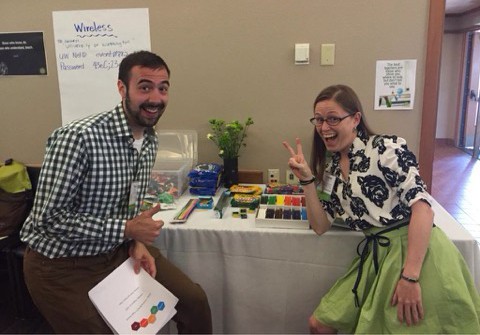
I just returned home from ECET2-Puget Sound, an amazing one-day celebration of innovation in education. ECET stands for “Elevating and Celebrating Effective Teachers” and the day most definitely did that! I was invited – with my friend and Seattle EdTech Meetup co-conspirator Steve Siden – to present two workshops on Design Thinking (DT). Our morning session was an introduction to design thinking for those new to the mindset, and our afternoon session was an advanced deep-dive to learn and practice some more flexibility with the processes of design thinking. We hope that our structure is replicable so that others can also bring design thinking into their learning environments!
Introduction to Design Thinking
“How Might We… support keeping energy positive and healthy throughout the school day?”
We based this workshop on a session in which I introduced my own school faculty to design thinking two years ago. With only 1 hour and 15 minutes, we decided to focus on a linear map of the design thinking process, rather than trying to really support our participants in understanding the cyclical phase nature of deep DT.
- We opened with an opportunity to share stories and led participants through crafting tighter “HMW” statements for their partners. Design thinking has taught me the value of storytelling in learning!
- We shared the story of Jane Chen and the Embrace infant incubator as a powerful example of the importance of deeply understanding your user/audience/partner’s needs. The empathy phase of design thinking is often the most challenging, but most critical to transformational success.
- Participants brainstormed individually and as groups, and participated in a couple fun divergent thinking exercises to “get the creative juices flowing.” Those exercises can be powerful for some, but confusing for others… several participants mentioned that it felt like a distraction from the task at hand. Perhaps that’s a good thing – to get out of your head and then go back in.
- Participants were only able to go through a single session of prototyping in our very tight schedule, but they completed their initial prototypes and then gallery-walked while also posting reflections on sheets posted around the room.
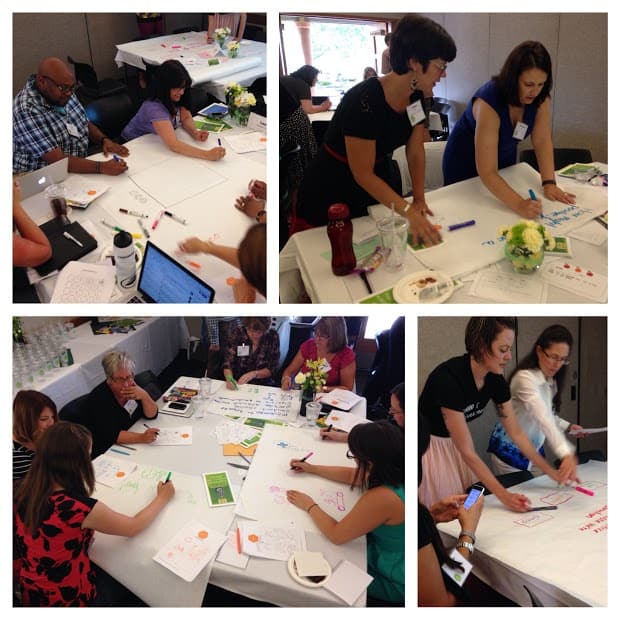
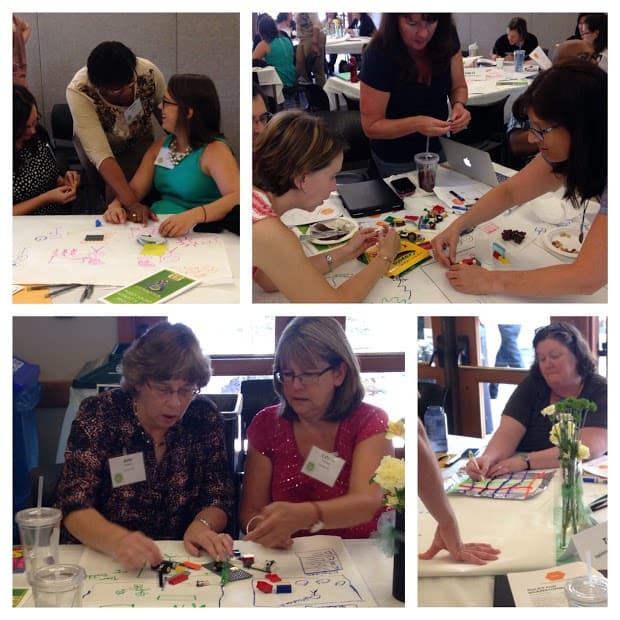
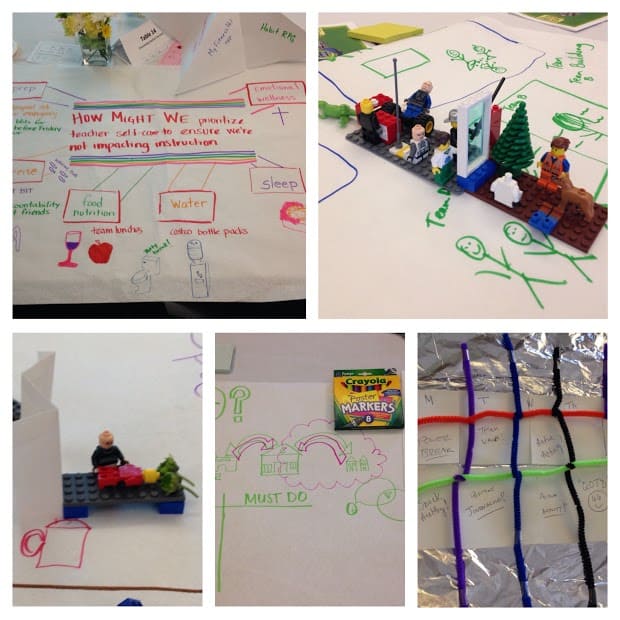
Outcomes
We invited participants to reflect on 5 questions at the end of the session, and their reflections were poignant. I highlighted a few reflections that stood out to me as particularly interesting.
1. What would be helpful for you to begin implementing some of these ideas in your classroom, or in the wider community with your colleagues, parents, or other groupings? What do you need next?
- Websites, time to discuss
- Use the idea of Design Thinking as a mini-lesson for staff
- Time to think about implementation
- More practice!
- I think I might need to experience this again before I lead others
- Twitter pals – thanks!
- video clippings of work in action
- I need more direction, studying to implement some of these ideas
- time!
- Some templates for implementation
- More practice, training
2. What’s the value that Design Thinking can bring to your school community? To your students’ learning experience?
- Students excited about learning, applying real world skills
- Giving everyone a voice – all ideas/problems are valued
- Think as a team vs just doing the same old thing
- Teacher voice, broad range of ideas
- DT could help students express how they are inspired by learning
- Channel frustration/hopelessness into action
- Community voice, school-wide integration
- Kids can realize there is not always 1 right answer, creativity is a good thing!
- Help students see relationships betw school and life
- Encourage creative iterative thinking!
- Empathizing and ideating
- iInspiring problem solvers who take initiative
- Flexibility
- Give power to all involved
3. How does Design Thinking align with your professional mission and vision? With your school’s mission and vision?
- Continue to grow and improve
- Healthy teachers are more effective
- Shift in teaching practices
- This would be new to my school. We do not have design thinking.
- Similar to NGSS ed -> bonus!
- Change is good
- Design thinking is in line with my goal of project based learning next year
- Real world learning emphasis in classrooms
- Supports innovative and creative thinkers
- Student engagement
- Critical and creative thinking
- DT gives me ideas for inspiring student learning and connections
4. What’s an example of an existing project or endeavor at school that you could tweak to harness the whole Design Thinking process?
- Student leadership club – design a service project based on community needs
- Testing
- All of my PBL activities
- My existing digital citizenship project could be tweaked to harness design thinking
- Apply DT to teaching argumentation
- Buddy goals
- STEM project
- This design thinking reminds me of QFT which I’ve used before
- PLC
- Mindset work with students
- Building mindful warriors
- Staff meetings! solving problems collaboratively
5. Where are other areas around your school and personal community where you could envision the Design Thinking mindset being useful, besides within your classrooms?
- Parenting
- Holistic balance
- Planning for own health, meals, activity
- Working out scheduling issues
- Staff meetings, problem solving time amangement
- IEP meetings, relationships personal level
- Blogging / writing projects
- Ways to lead from the front of classroom
- Working with difficult students -> brainstorming what to do / where to start and creating a solution
We heartily invite you to steal elements from either our presentation slide deck or our workshop handout for your own workshop. Credit is always appreciated. 🙂
Advanced Design Thinking
“How Might We benefit from the mindsets of design thinking within our school communities?”
With again only 1 hour and 15 minutes, we designed the advanced workshop to help participants with at least some exposure to design thinking begin to use the mindset more flexibly and think about some of the nuances that can make the process more effective.
- We again opened with sharing stories and pain points. This time, we followed the story telling with Jenn Chan of Exhibit Change‘s Oreo activity. We invited each participant to simply eat an Oreo we’d placed at their tables. As participants shared their process for eating an Oreo, we had a nice treat, some silly laughs together, and noticed the important lesson that we each experience even seemingly trivial activities very differently. With deep knowledge that different perspectives and experiences can elicit very different interpretations of a “problem,” the empathy phase of DT can bring about very different pinpoints for solvable problem statements.
- We did a mini-loop of the full design thinking process just around reframing each group’s HMW problem statement… We had individuals and groups brainstorm pain points out of the storytelling outcomes, reframe those pain points as opportunities, then prototype and “test” (share and discuss) new HMW statements very specific to their identified pain points. This process had some very interesting outcomes. It was challenging… several groups tried to jump straight to solution-brainstorming, and we talked through the idea of brainstorming what the problem itself actually is. Ultimately, though, it resulted in some very precise and exciting HMW statements. For example, one group tweaked from “HMW support kids in effectively using new skills they’ve learned?” to “HMW support kids in transferring skills learned within one context to new contexts?”
- Sharing these final HMW statements, we had some interesting conversations about presupposing a solution. One group struggled heavily with this… Their “final” HMW statement was “How might we prioritize curriculum to keep energy high across the school year?” Through discussion, they noticed that this did indeed presuppose a solution (prioritizing curriculum) to a problem that was not fully understood (flagging energy 3/4 into the school year). Sometimes it might take significant observation and reflection simply to best articulate the problem. In this case, that might mean a full year of close observation around changes at that time of the school year before defining exactly what the problem is that needs to be solved.
- From there, we followed a more typical design thinking pathway – ideation, divergent thinking activities (different from the morning ones), further ideation, prototyping. We ran out of time with just one round of prototyping, and ended with again posting reflections to some questions.
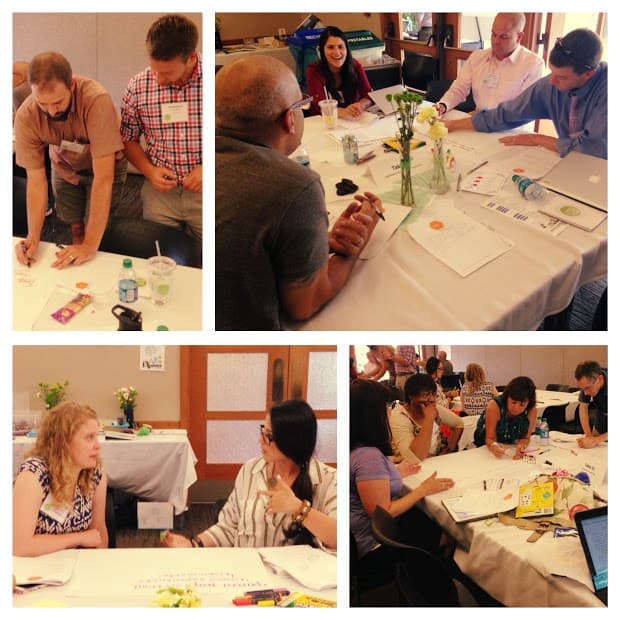
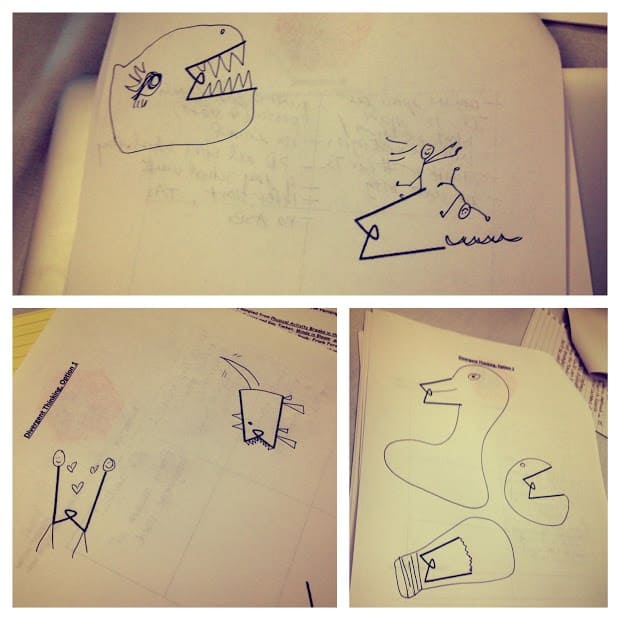
Outcomes
We invited participants to reflect on four questions at the end of the session, and this new group’s reflections were as poignant as the morning group. I highlighted a few reflections that stood out to me as particularly interesting.
1. Which are the design thinking “phases” or “cycles” that come most easily to you? Why do you think that might be?
- Empathize, prototype
- Brainstorming – easy for me to listed to others
- Identifying problems
- Thinking of solutions. There is power in thinking solution-oriented!
- Ideate because it’s solution-oriented and optimistic
2. Which are the design thinking “phases” or “cycles” that feel least comfortable to you? Why do you think that might be?
- Define – “pin pointing is hard!!!”
- Prototyping – pressure to create in a set time frame
- Define – pin pointing anything is hard Yes, different handwriting
- Re-defining
3. Reflect on the feeling of having a third party reframe your pain points as opportunities. What mindsets would make that reframing easier? Harder?
- Reframing by partner was useful
- I like that the 3rd party isn’t emotionally involved
- It’s personal, so “hard” but usually rewarding
- The reality of the situation vs how you see it
- I can always use someone else to reframe my questions
4. Reflect on the feeling of presenting a prototype solution to your partner, coming from outside their school environment?
- This would be hard to understand/capture the empathy piece and feel understood
- There are no “that’s not going to work”
- Vulnerable
We also heartily invite you to use our advanced DT slide deck or advanced DT handout. Credit is always appreciated.
While I always enjoy introducing people new to design thinking, the advanced session was deeply satisfying in that I got to dig deep with participants on some of the purposes of design thinking. Myself, I’m prone to wanting to leap straight to brainstorming and problem-solving. Design thinking has helped me tremendously in understanding how to deeply probe multiple perspectives and causes in a situation and/or problem before tackling it – a valuable skill for leadership and inclusivity.
For more blogs by Lindsey, check out:
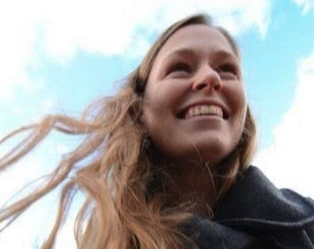


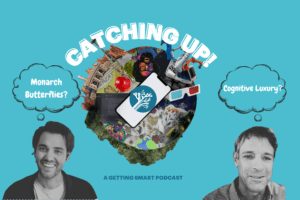

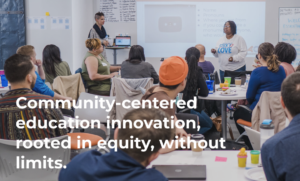

Mark Rounds
Thanks a million for posting these resources. I am wanting to facilitate some DT workshops with like-minded teachers in my district and will TOTALLY be stealing, err "borrowing," some of you resources FOR SURE.